What does AGP do and what to expect from its alternatives
Published: June 27, 2022
By: Aminul Islam; DVM, MS.
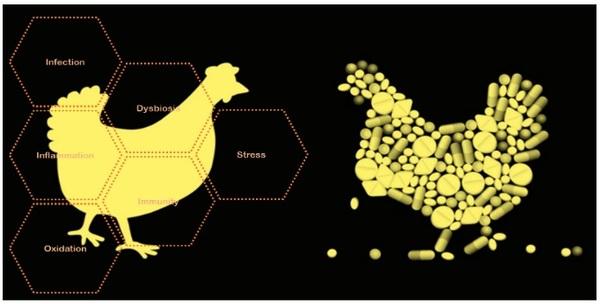
The history of antibiotic use in poultry feed is quite old and in a very short period of time it gained a special identity as an antibiotic growth promoter (AGP). There is no doubt, this special name came from its proven effect on the growth performance. However, Health officials desperate to maintain the efficacy of antibiotics, see AGPs as a wasteful use and already secure the legal stand to ban these. This has therefore warranted the urgent need for alternatives and so many natural agents have been identified through research over the past few years. Since none of these exactly match the AGPs and they are too large in number with similar effects makes an obstacle for animal producers to choose the right one or right combination. So, no doubt it’s better to look back to the needs of poultry before going for products in the market. Proper understanding of the underlying facts induced by AGPs in growth performances and what is really expected in absence of AGPs can help in this case.
AGPs have positive effects on growth performance through surprising modes of actions. Pathogens, the most common culprits, cause thousands of consequences to spoil the growth aids in bird’s physiology. In a very specific way, AGPs are used to control these pathogens and thereby accelerate growth. An ideal alternative should have the same beneficial effects of AGPs, supporting bird’s physiology to achieve the performance as per bird’s genetic potentials. In absence of AGPs infection, inflammation, immune suppression and dysbacteriosis become the major concern that strongly demands to be solved by the use of alternatives.
Keeping birds free from Infections:
In modern poultry production systems, the infection or pathogens are one of the major constraints in achieving good performance. High flock size along with a lot of involvement make it more prone to easy escape of biosecurity measurement. Thus, the initiatives to control infection in birds are somewhat mandatory. Antimicrobial effects of phytobiotics and organic acids are highly appreciated nowadays in absence of AGPs to do this. As the effects of this class of alternative are not much stronger as AGPs, full protection without additional support for physiological well-being of birds is quite impossible.
In recent studies, the enzyme Glucose oxidase (GOD), having antibacterial and antifungal effects by catalyzing the oxidation of β-D-glucose into 2-δ-gluconolactone and hydrogen peroxide, found to be a potential solution in absence of AGPs. Use of short & medium chain fatty acids, essential oils, prebiotics are also commonly used to prevent infections.
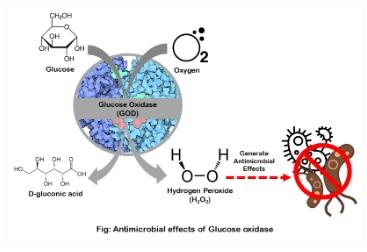
Prevention of Inflammation:
Inflammatory reactions and oxidative stress are very common in growing chicken and mostly involved in the gut. Apart from acute pathological inflammation (due to infections), the most recurrent kind of gut inflammation in birds is sterile inflammation (due to non-infectious stimuli). Moreover, any type of intestinal inflammation will generate ROS, which will lead to a state of oxidative stress in the gut. These together cause serious damage to the intestinal integrity and hamper the normal function of the gut. Moreover, inflammation usually asks for a lot of physiological attention and wastes energy allowing for productivity. So, along with measures to check infections, measures to reduce inflammatory effects are highly recommended in absence of AGPs in helping growth by rapid restoration of cellular function, energy saving and healthy sealing of first line defenses.
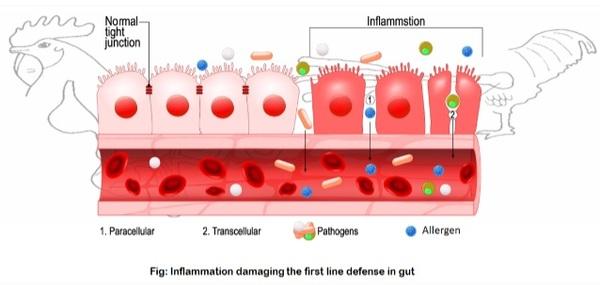
Boosting Immunity:
There are so many factors that can impact the performance of the immune system and have a direct influence on health and productivity. Interpreting research findings and evidence it is well accepted that immune compatibility requires a basic understanding of the immune system to offer birds an immune boosting program. For example, what can be achieved by vaccines, can’t be achieved by nutrition. However, stronger immunity makes the bird stronger enough to fight infections. So, in absence of AGPs it is almost mandatory to keep the immunity strong enough. Certain phytogenic, Vitamin-Minerals and hyper immune IgY can favor birds to get immunity at optimum level to fight infections. Moreover, free radicals damage the highly proliferative enterocytes, making a gateway for systemic infections and less efficient to perform digestion and absorption of nutrients. Antioxidant vitamins, minerals, plant bioactive molecules to protect the damage and zinc, vitamin-A, butyrate for rapid healing by regeneration of enterocytes are of great choice to enhance first line defense.
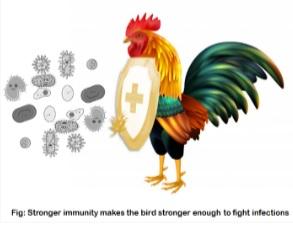
Set a healthy microbiota:
As the gut is the main entry for pathogenic microorganisms into the body tissues, thus on gut health studies the maximum attention is usually paid on control of specific enteric infection (Eimeria spp, Clostridium perfringens, E. coli and Salmonella spp). And, it is common practice that AGPs are used to control pathogens but it is not surprising to see that AGPs feed flock suffering from serious gut issues. So, something is there need to be considered to optimize gut health. This is gut microbiota; advanced research suggests more attention to gut health studies. The chicken gut microbiota comprises more than 100 trillion microorganisms with a diverse population of bacteria, fungi, protozoa, and viruses. Bacteria among them are most dominant and play a diversified role in intestinal functions; they help in digestion, developing local immunity, and intestinal health. Gut microbiota is also an important component of Gut-brain axis in chicken. On the other hand, in absence of AGPs, the gut becomes more prone to pathogen growth that leads to serious demand for friendly microbial rehabilitation to ensure gut microbial balance.
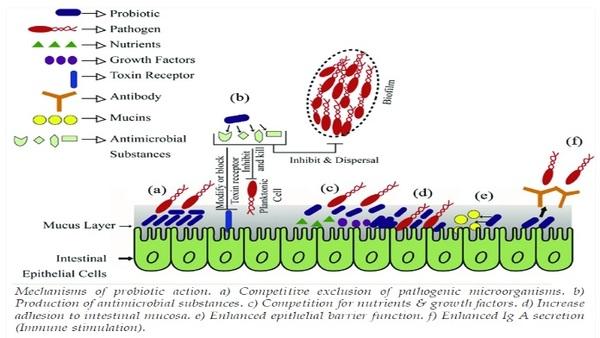
In absence of AGPs or AGPs induced gut issues, a holistic approach to set up a gut microbiota equilibrium is essential. Without gut microbial equilibrium it is quite impossible to stimulate performances of birds. Probiotics, prebiotics and to a more extent Postbiotics in this case might have proven benefits.
Therefore, the search for the alternatives to AGPs and its use is not bound to meet the direct mode of action of AGPs, rather something potent to compensate for the physiological barriers of the production performance.
Disclaimer: The views expressed in this article are based on Author’s knowledge gathered from attending different seminars, webinars, symposiums, free access journals and different articles published in internet media on AGPs & alternatives to AGPs. Author will be pleased to deliver the sources of information upon due request.
Related topics:
Authors:
BioGreen International Limited
Recommend
Comment
Share

Would you like to discuss another topic? Create a new post to engage with experts in the community.








.jpg&w=3840&q=75)